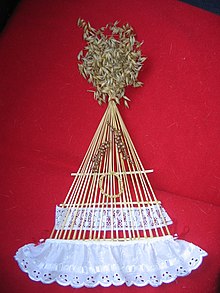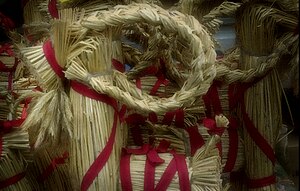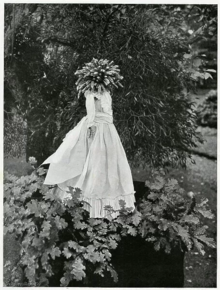Corn dolly

Corn dolliesorcorn mothersare a form ofstrawwork made as part ofharvestcustoms of Europe before mechanisation.
Scholars of the 18th and 19th centuries theorized that beforeChristianisation,in traditionalpaganEuropean culture it was believed that the spirit of the corn (inAmerican English,"corn" would be "grain" ) lived amongst the crop, and that the harvest made it effectively homeless.James Frazerdevotes chapters inThe Golden Boughto "Corn-Mother and Corn-Maiden in Northern Europe" (chs. 45–48) and adduces European folkloric examples collected in great abundance by thefolkloristWilhelm Mannhardt.Among the customs attached to the lastsheafof the harvest were hollow shapes fashioned from the last sheaf ofwheator othercereal crops.The corn spirit would then spend the winter in this home until the "corn dolly" wasploughedinto the first furrow of the new season.
Background
[edit]James George Frazerdiscusses theCorn-mother and the Corn-maideninNorthern Europe,and the harvest rituals that were being practised at the beginning of the 20th century:
In the neighbourhood ofDanzigthe person who cuts the last ears of corn makes them into a doll, which is called the Corn-mother or the Old Woman and is brought home on the last waggon. In some parts ofHolsteinthe last sheaf is dressed in women's clothes and called the Corn-mother. It is carried home on the last waggon, and then thoroughly drenched with water. The drenching with water is doubtless a rain-charm. In the district ofBruckinStyriathe last sheaf, called the Corn-mother, is made up into the shape of a woman by the oldest married woman in the village, of an age from 50 to 55 years. The finest ears are plucked out of it and made into awreath,which, twined with flowers, is carried on her head by the prettiest girl of the village to the farmer orsquire,while the Corn-mother is laid down in the barn to keep off the mice. In other villages of the same district the Corn-mother, at the close of harvest, is carried by two lads at the top of a pole. They march behind the girl who wears the wreath to the squire's house, and while he receives the wreath and hangs it up in the hall, the Corn-mother is placed on the top of a pile of wood, where she is the centre of the harvest supper and dance.[1]

Many more customs are instanced by Frazer. For example, the term "Old Woman" (Latinvetula) was in use for such "corn dolls" among theGermanic pagansofFlandersin the 7th century, whereSaint Eligiusdiscouraged them from their old practices: "[Do not] make vetulas, (little figures of the Old Woman), little deer or iotticos or set tables [for the house-elf, comparePuck] at night or exchangeNew Yeargifts or supply superfluous drinks [aYulecustom]. "[2]Frazer writes: "In East Prussia, at the rye or wheat harvest, the reapers call out to the woman who binds the last sheaf, “You are getting the Old Grandmother....In Scotland, when the last corn was cut afterHallowmas,the female figure made out of it was sometimes called theCarlin or Carline,that is, the Old Woman. "[3]
The mechanisation of harvesting cereal crops probably brought an end to traditional straw dolly and figure making at the beginning of the 20th century.[4]In the UK corn dolly making was revived in the 1950s and 1960s. Farm workers created new creations including replicas of farm implements and models such as windmills and large figures.[5]New shapes and designs with different techniques were being created. In the 1960/70s several books were published on the subject. (seeLettice Sandford) The simple origins of the craft had been lost and new folk lore stories were added to the original ideas.[6]
ThePitt Rivers Museum[7]in Oxford and theMuseum of English Rural Lifein Reading both have collections of corn dollies from around the world.[8]
Materials used
[edit]- Great Britain:mainlywheat,oats,ryeandbarley
- Ireland:rush
- Southern France:palmleaves
With the advent of thecombine harvester,the old-fashioned, long-stemmed and hollow-stemmed wheat varieties were replaced with knee-high, pithy varieties. However, a number ofEnglishandScottishfarmers are still growing the traditional varieties of wheat, such asMaris Wigeon,Squarehead Master, Elite Le Peuple.[9]mainly because they are in great demand inthatching,a craft which is enjoying a renaissance, with customers facing long waiting lists for having their roofs thatched or repaired.
Types
[edit]Corn dollies and other similar harvest straw work can be divided into these groups:
Traditional corn dollies named after counties or place names of England, Scotland and Wales
[edit]-
Barton Turfdolly,Norfolk
-
CambridgeshireHandbell
-
HerefordLantern
-
SuffolkHorseshoe
-
YorkshireSpiral or Drop Dolly
- Other corn dollies includeAnglesey Rattle, Cambridgeshire Umbrella, Durham Chandelier, Claidheach (Scotland) Herefordshire Fan, Kincardine Maiden (Scotland), Leominster Maer (Herefordshire), Norfolk Lantern, Northamptonshire Horns, Okehampton Mare, Oxford Crown,SuffolkBell, Suffolk Horseshoe and Whip, Teme Valley Crown (Shropshire), Welsh Border Fan, Welsh Long Fan, Worcester Crown.
- There are also corn dolly designs from other countries, for example the Kusa Dasi fromTurkey,named after the town ofKuşadası.
Countryman's favours and other harvest designs
[edit]Acountryman's favourwas usually aplaitof three straws and tied into a loose knot to represent a heart. It is reputed to have been made by a young man with straws picked up after the harvest and given to his loved one. If she was wearing it next to her heart when he saw her again then he would know that his love was reciprocated. Three straws can be plaited using the hair plait or a cat's foot plait. Favours can be made with two, three, four or more straws.
-
Countryman's Favour inbarley
-
Glory Braid
-
Cornucopia (Horn of plenty)
-
Corn Maiden
-
Harvest Cross
-
Harvest Wreath
-
Corn maiden
-
Countryman's Favours
Other examples include:
- Bride of the Corn ( "Aruseh" in North Africa)
- Devonshire Cross, a harvest cross fromTopsham,Devon
- Dedham Cross
- St Brigid's Cross; theNational Museum of Irelandhas many examples of harvest crosses.
Fringes
[edit]- Larnaca Fringe
- Montenegrin Fringe
- LancashireFringe
Large straw figures
[edit]

These are representations of animals or humanoid beings made from an entire sheaf. They are known by a variety of names, depending on location and also the time of harvesting:
- The GoddessCeres[citation needed]
- Maiden or Bride (harvest beforeAll Saints):
- Kirn Dolly (Roxburghshire)
- Kirn Baby (Lothians)
- Kern Baby (Northumberland)
- The Neck(Cornwall and Devon)
- Hare (Galloway)
- Lame Goat,Scottish Gaelic:gobhar bacach (Harris,Skye,Glenelg)
- Straw dog -strae bikko(Shetland,Orkney)
- CailleachGaelic: Old Woman or The Hag (harvest after All Saints)
- Caseg Fedior harvest mare in Wales.
- 'Y Wrach' or 'The Hag' in Caernarvonshire, Wales
- WhittleseyStraw Bear, the centre of a ceremony in Whittlesey, Cambridgeshire, every January. Its origins are obscure.
Tied straw work
[edit]Here the straw is not plaited, but tied with yarn, wool,raffiaor similar. This type of straw work is particularly popular inScandinaviaandGerman-speaking countries. Examples of these are theOro(Swedish Straw Crown); theTomteor Nisse; and smaller versions of theYule Goat.
-
Tied straw work
-
Swedish Dwarves
-
Reindeer garland
-
Large tied star
Ridge finials
[edit]- These are straw sculptures which are placed on the ridge of thethatched roof.They are sometimes purely for decoration, but can be the signature of a particular thatcher. Animal shapes (birds, foxes etc.) are the most common. In days gone by, hay-ricks would also be thatched, and topped with a straw decoration.
See also
[edit]- Æcerbot
- Corn husk doll
- Crying the Neck
- Didukh,sheaf of grain, believed to contain spirits, and also stored inside the house over winter, in East Slavic cultures.[citation needed]
- Food grain
- Harvest festival
- John Barleycorn
- Kadomatsu
- Mistletoe
- Poppet
- Straw plaiting
- The Corn Dollies(band)
- TheGreen Man
- Wicker man
References
[edit]- ^The Golden Bough,chapter 45
- ^Saint Ouen of Rouen;trans. Jo Ann McNamara.The Life of Saint Eligius (Vita Sancti Eligii).Archived from the original on 2013-05-08.
{{cite book}}:CS1 maint: bot: original URL status unknown (link) - ^Frazer, ch. 45.
- ^Adkins, Roy and Lesley."Corn Dollies".Adkins History.Adkins History.Retrieved6 December2019.
- ^Mizen, Brian."Fred Mizen".Fred Mizen.Brian Mizen Thatching.Retrieved6 December2019.
- ^Carpenter, Daniel."Corn Dolly Making".Corn Dolly Making.Heritage Crafts Association.Retrieved6 December2019.
- ^"Harvest Trophies".England: The Other Within.Pitt Rivers Museum.Retrieved6 December2019.
- ^"Coker, Alec (corn dollies)".Coker, Alec (corn dollies).Museum of English Rural Life.Retrieved6 December2019.
- ^"Guild of Straw Craftsmen - Frequently asked questions".Strawcraftsmen.co.uk. 2008-08-16.Retrieved2014-06-25.
Further reading
[edit]- Discovering Corn DolliesBy M. LambethISBN0-85263-283-5
- Corn Dollies: Their Story, Traditions and How to Make Themby David J KeighleyISBN0-9504215-0-2
- A Golden Dolly, the Art, Mystery and History of Corn Dolliesby M. Lambeth
External links
[edit]- Sir James George Frazer,The Golden Bough,chapter 45, and § 2.The Rice-mother in the East Indies
- The Guild of Straw CraftsmenUK association for all aspects of straw craft
- "Putting out the hare, putting on the harvest knots"Irish harvest customs
- Neil ThwaitesYorkshire corn dolly crafter




















